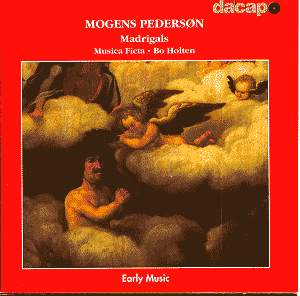Many countries in Europe experienced a period of political
power and economic wealth that created a 'Golden Age', with the
arts and sciences flourishing. When England had its 'Elizabethan
Era' and Venice was a centre of culture, Denmark had its 'Christian
IV period'. Like Elizabeth, Christian IV was a great connoisseur
and lover of the arts, and ready to spend enormous sums of money
to show his wealth and status to the outside world, in particular
other rulers and courts in Europe. Competition was without any doubt
an essential element in the demonstration of pomp and splendour.
As music at the courts in Europe was highly international, it is
no surprise that foreign composers were attracted to compose and
perform music at the court in Copenhagen, including such famous
composers as John Dowland and Heinrich Schütz.
Some Danish composers also contributed to the
flourishing of music. Unfortunately, very few works by Danish
composers have survived. Many of the works composed for the Danish
court have been fallen victim to fires. From the period before
1800 only a small number of collections by Danish composers are
extant. Most of them are Italian madrigals by composers like Borchgrevinck,
Brachrogge and Pederson.
Like other composers from all over Europe - Heinrich
Schütz, for instance - Mogens Pederson went to Italy to study
the newest trends in music. When he was an apprentice in the King's
'cantori', Pederson was sent to Italy in 1599, accompanied by
Borchgrevinck, on a one-year study trip. In 1605 he went to Venice
again, for a period of four years this time, to study with Giovanni
Gabrieli. Usually composers who had spent some time with the great
master published a collection of madrigals, showing the results
of their studies. Pederson was no different, and published his
'Madrigali a cinque voci, Libro primo' in 1608. It contains 21
madrigals, some in two parts.
Later, Pederson went to England, perhaps to visit
Queen Anne, sister of Christian IV, who was married to King James
I. In 1618 he was appointed as deputy chapelmaster, a position
he held until his death in 1623.
The first collection of madrigals shows that
Pederson was a fine composer who knew how to set Italian texts
to music. There are several passages with typical Italian 'madrigalisms'.
In this collection we find mostly the kind of texts that composers
preferred for writing madrigals, usually about (unhappy) love.
In particular here, harmony was an important device to illustrate
the content of the text. As far as expressiveness is concerned,
Pederson is somewhat moderate in comparison with the Italian masters
of the madrigal or even Heinrich Schütz.
The amount of expression is difficult to assess,
though, on the basis of this recording. "Musica Ficta is a professional
vocal ensemble that cultivates virtuoso ensemble singing in all
its nuances - not least works from the Golden Age of vocal polyphony,
the Renaissance", according to the booklet. It lists seven singers,
but doesn't tell whether they all sing all the time.
The main problem of this recording is a general
lack of differentiation. Most madrigals are sung 'forte' or 'fortissimo',
and the expression of the text is limited. The way of singing
here is too straightforward and perhaps more suitable to motets
and masses than to madrigals.
The acoustics arenít ideal either. The recording
was made in a chapel, whereas for this kind of repertoire one
would like a more intimate atmosphere. But in the end more intimacy
doesn't help when the singers don't show much sensitivity to the
material they are dealing with.
I can recommend this recording only to those
who are very curious to know what Pederson's music is like. If
you want a recording of madrigals just to enjoy, look elsewhere.
Johan van Veen


![]() Director: Bo Holten
Director: Bo Holten ![]() DACAPO 8.224219
[57:42]
DACAPO 8.224219
[57:42]